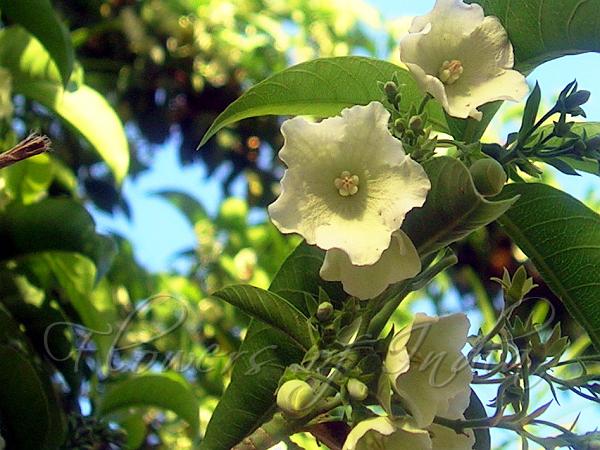|
| Bread Flower |
|

|

| File size | 249545 |
| Original date | 4/2/07 5:00 PM |
| Resolution | 2048 x 1536 |
| Flash | Flash did not fire, auto |
| Focal length | 8.0mm |
| Exposure time | 1/213s |
| Aperture | 3.2 |
| Focus Distance | |
| Metering Mode | Partial |
| Camera make | NIKON |
| Camera model | E3700 |
| Sensor type |
|
|
|
Photo: |
Botanical name: Vallaris solanacea Family: Apocynaceae (Oleander family)
Synonyms: Peltanthera solanacea, Vallaris heynei
Synonyms: Peltanthera solanacea, Vallaris heynei
This plant was earlier names in honour of Frederick Adolf Heyne, a German
botanist. Native to India and Burma, Bread Flower is a hairy, climbing shrub.
Stems are covered with a
gray, spotted bark, emitting a white latex when wounded. Oppositely arranged,
elliptic-oblong leaves can be as large as 5x2 inch. White, fragrant,
bowl-shaped flowers, 1 inch across, occur in 3-6 flowered cymes in leaf axils.
The 5 sepals, up to 2.5 mm long are narrow, pointed. The 5 petals are circular
in shape. The flowers have an intense, interesting
fragrance, a liking for which may not be universal. The smell is said to be
close to that of pandan leaves, a relative of
Kewda, which is used to flavour rice in some South-East Asian countries.
Interestingly, a study of the basmati/jasmine flavor molecule,
2-acetyl-1-pyrroline, 2AP for short, notes that 2AP is produced through almost
the whole of basmati rice plant. It's also found at very high levels in
pandan leaf, and in "bread flowers." Bread flower is an essential
ingredient of the ‘bunga rampai’, the decorated arrangement of
finely sliced, fragrant leaves used for Malay weddings.
Bread flower vine can be trained as a compact bush and is good for container
culture. Attracts butterflies and hummingbirds.
Flowering: December-April.
| Identification credit: Tabish | Photographed in IIT Campus, Delhi |
• Is this flower misidentified? If yes,